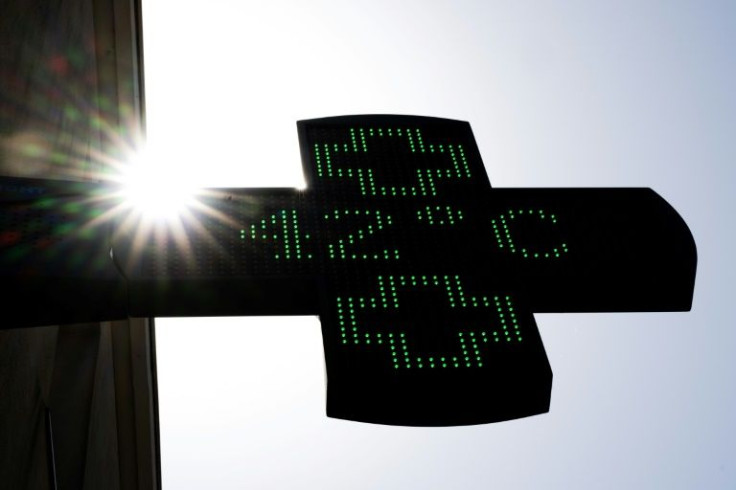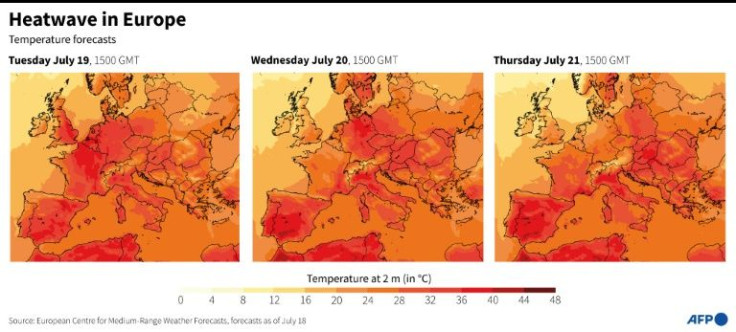Climate Deniers Sow Weather-map Heatwave Misinfo
Climate-change deniers have a viral way of spreading misinformation on social media during a heatwave: by publishing weather maps out of context to imply forecasters are exaggerating global heating.
During the two recent heatwaves in Europe, users in various countries and languages misleadingly juxtaposed weather maps, suggesting the colours had been changed to red by media or authorities seeking to create panic.
AFP Fact Check has debunked several versions of the claim, which have surfaced in languages including English, German, Spanish, French, Hungarian and Polish.
"LEFT - Old school weather forecast. Happy and sunshiny. Right - New style weather forecast. Designed to look like fear and destruction. It's called summer," read a text with one pair of UK weather maps shared on Twitter during this week's British heatwave.
The two side-by-side maps under the post showed hot weather over Britain. The left one was light green with sun symbols, the right-hand one dark red.
UK Met Office weatherman Aidan McGivern branded it a "ridiculous comparison," in his own Twitter thread.
He said the colour scheme had been redesigned last year to make the contrasts more visible to those who were colour blind.

"The new temperature colour scale does go darker (red) when it gets hotter (especially >38.7 C, the UK record)," he said. "It also goes darker (blue) when it gets colder."
He added that the right-hand image was from a "one-off" Met Office tweet dating from 2016 - not from the current heatwave.
One post shared in Spanish and Catalan during this week's heatwave said: "Now they have to colour the map as if we were in hell itself."
The two side-by-side maps under the post showed hot weather over Spain. One was white with sun symbols, the other dark red.
A digital investigation by AFP revealed they were two different types of map, from different sources - not, as the post claimed, from a single forecaster that had manipulated its colour scheme.
In English and German, numerous similar claims circulated during hot weather in May and June.

One Facebook post showed side-by-side maps showed similar temperatures over Sweden. One was green and dated 1986, the other orange and dated 2022.
A digital investigation revealed that the years on the maps were incorrect and they were from different news organisations that use different colour codes.
Thousands of social media users shared the same image in French, claiming it was evidence of a "global warming scam."
Posts in Germany in June showed two maps from the news show Tagesschau, claiming it had changed their colour from green in 2009 to red in 2019 to hype the climate threat.
Tagesschau explained that the red map was a temperature forecast, and even in 2009 such maps had used red. The green one was a general weather forecast with different colour scheme and variables.
Climate scientists overwhelmingly agree that carbon emissions from humans burning fossil fuels are heating the planet, raising the risk and severity of heatwaves and other extreme weather events.
With temperatures topping 40 C, the heatwave in Britain this week prompted comparisons with the summer of 1976, when the temperature peaked at 35.9 C.
"Of course there have been heatwaves in the past, but the big difference with 1976 is what the rest of the world looked like," said Friederike Otto, senior lecturer at Imperial College London's Grantham Institute for Climate Change.
"In '76 there was a heatwave in (Britain), in 2022 there are heatwaves everywhere in the world and so there have been in 2021, '20, '19," she told reporters on Monday.
Nostalgia for 1976 -- sometimes accompanied by misleading map-sharing -- irritated some users on social media.
"Folk keep sharing the fake f**king image showing 'WEATHER in my day' bla bla bla," wrote one user, identified as Talent Stockport, on July 17.
"Its misleading" (sic), the post continued. "Your spreading miss information which could actually put peoples lives in danger, and its the same type of people too. The people who are unable to process basic facts."
The fact-check investigations cited in this story can be found in different languages at factcheck.afp.com.
© Copyright AFP {{Year}}. All rights reserved.





















